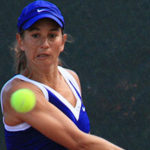If you have any questions or concerns, please contact us.
Playing Tennis Safely: Player Tips and Recommendations

PRINTABLE PDF DOWNLOAD: Playing Tennis Safely flyer
PRINTABLE PDF DOWNLOAD (ENGLISH | SPANISH)
The USTA recognizes that the coronavirus has been affecting different parts of the country in different ways and with different timing. We therefore believe it will be possible for people to return to playing tennis safely in some cities and states sooner than in others.
The Federal Government issued guidelines on April 16 for “Opening Up America Again” at WhiteHouse.gov/OpeningAmerica. By following these guidelines as well as those of local governments and health agencies, facilities and players will be able to make informed decisions as to when play can recommence.
If you live in a community where stay-at-home or shelter-in-place orders have been lifted or modified, and if your locality meets the standards in the Federal Guidelines, then tennis, if played properly, can be a great opportunity for you to relieve stress, socialize with others and provide much-needed exercise. Of primary importance is taking every precaution to help keep all participants safe.
Because tennis does not require any direct person-to-person contact, players can enjoy the many physical and mental benefits that tennis offers so long as you practice physical distancing by keeping six feet apart from other players to ensure you are in a safe exercise environment and follow other safety recommendations included here.
Although there is no specific evidence that tennis balls can spread COVID-19, we know that contamination by respiratory droplets from an infected person can potentially survive on hard surfaces up to three days. If you choose to play tennis, be sure to practice these safety tips and recommendations.
- Make sure that your state and region allow tennis play, satisfy the Federal Government’s gating criteria (as outlined in the “Opening Up America Again” guidelines) and has been designated an essential business and/or has entered Phase One of the Phased Comeback.
- States and regions with no evidence of a rebound and that satisfy the gating criteria a second time may proceed to Phase Two of the Phased Comeback, in which all individuals, when in public recreation areas, should maximize physical distance from others.
- Be aware that although restrictions are eased when your state and region move from Phase One to Phase Two or Phase Three of the Phased Comeback, safety precautions must remain in place until there is a universal vaccine or effective treatment for the coronavirus.
- The USTA Medical Advisory Group highly recommends competitive players ease their way back into play prior to competition. Given the layoff from competing, players will be more susceptible to under-training, over-use and other injuries. The USTA strongly recommends at least three weeks of on court and off court conditioning before competition begins.
- Arrange to play only with family members or others who live in your household or with individuals who are considered to be low risk.
- Do not play if any of you:
- Are exhibiting any symptoms of the coronavirus. According to the CDC, people with COVID-19 have had a wide range of symptoms reported—ranging from mild symptoms to severe illness. These symptoms may appear 2-14 days after exposure to the virus: fever, cough, shortness of breath or difficulty breathing, chills, repeated shaking with chills, muscle pain, headache, sore throat, new loss of taste or smell.
- Have been in contact with someone with COVID-19 in the last 14 days.
- Are a vulnerable individual and your state and region is in Phase One or Phase Two. A vulnerable individual is an elderly individual and/or an individual with serious underlying health conditions, including high blood pressure, chronic lung disease, diabetes, obesity, asthma and those whose immune system is compromised such as by chemotherapy for cancer and other conditions requiring such therapy. (For states and regions in Phase Three, a vulnerable individual can resume public interactions, including playing tennis, but should practice physical distancing.)
- Protect against infections:
- Wash your hands with a disinfectant soap and water (for 20 seconds or longer), or use a hand sanitizer if soap and water are not readily available, before going to the court.
- Clean and wipe down your equipment, including racquets and water bottles. Do not share racquets or any other equipment such as wristbands, grips, hats and towels.
- Bring a full water bottle to avoid touching a tap or water fountain handle.
- Use new balls and a new grip, if possible.
- Consider taking extra precautions such as wearing gloves.
- If you need to sneeze or cough, do so into a tissue or upper sleeve.
- Arrive as close as possible to when you need to be there.
- Avoid touching court gates, fences, benches, etc. if you can.
WHEN PLAYING
- Try to stay at least six feet apart from other players. Do not make physical contact with them (such as shaking hands or a high five).
- When playing doubles, coordinate with your partner to maintain physical distancing.
- Avoid touching your face after handling a ball, racquet or other equipment. Wash your hands promptly if you have touched your eyes, nose or mouth.
- Avoid sharing food, drinks or towels.
- Use your racquet/foot to pick up balls and hit them to your opponent. Avoid using your hands to pick up the balls.
- Maintain physical distancing if changing ends of the court.
- Remain apart from other players when taking a break.
- If a ball from another court comes to you, send it back with a kick or with your racquet.
- Leave the court as soon as reasonably possible.
- Wash your hands thoroughly or use a hand sanitizer after coming off the court.
- Do not use the locker room or changing area. Shower at home.
- No extra-curricular or social activity should take place. No congregation after playing.
- All players should leave the facility immediately after play.
USE FOUR BALLS OR SIX BALLS
Although unlikely, it’s possible that a tennis ball can transmit the COVID-19 virus, as virtually any hard surface can transmit the disease. So here is an extra precaution you can take to keep safe when playing tennis:
- Open two cans of tennis balls that do not share the same number on the ball.
- Take one set of numbered balls, and have your playing partner take a set of balls from the other can.
- Proceed with play, making sure to pick up your set of numbered balls only. Should a ball with the other number wind up on your side of the court, do not touch the ball with your hands. Use your racquet head or feet to advance the ball to the other side of the court.
Playing Tennis Safely: Facility and Programming Recommendations

RELATED: Safety of Playing Tennis for Players
PRINTABLE PDF DOWNLOAD: Playing Tennis Safely flyer
PRINTABLE PDF DOWNLOAD (ENGLISH | SPANISH)
The USTA recognizes that the coronavirus has been affecting different parts of the country in different ways and with different timing. We therefore believe it will be possible for people to return to playing tennis safely in some cities and states sooner than in others.
The Federal Government issued guidelines on April 16 for “Opening Up America Again” at WhiteHouse.gov/OpeningAmerica. By following these guidelines as well as those of local governments and health agencies, facilities and players will be able to make informed decisions as to when play can recommence.
Because tennis does not require direct person-to-person contact, players can enjoy the many physical and mental benefits that tennis offers so long as they practice physical distancing by keeping six feet apart from other players to ensure a safe exercise environment and follow other safety recommendations included in the Player Tips and Recommendations document that is being distributed along with this Facility and Programming Recommendations.
Tennis providers, coaches and facilities across the country are all different and operate in different local contexts. Making an assessment of whether a safe exercise environment can be provided depends on a range of factors, which apply differently at each venue. It is the responsibility of each tennis provider, coach and facility to make that assessment based on their local environment.
Know that the Federal Guidelines for Opening Up America Again is a three-phased approach, and safety precautions must remain in place as we move from Phase One to Phase Three until there is a universal vaccine or effective treatment for the coronavirus.
In communities where stay-at-home or shelter-in-place orders have been lifted or modified, and where the locality meets the standards in the Federal Guidelines, then tennis, if played properly, can be a great opportunity to relieve stress, socialize with others and provide much-needed exercise. Of primary importance is taking every precaution to help keep all participants safe.
ORGANIZE YOUR TENNIS ACTIVITIES
- Activity should always be in line with the Federal Government’s advised physical distancing measures (defined by the Centers for Disease Control and Prevention as keeping six feet apart), including when arriving at and departing from a court.
- Limit activities to casual court rental, one-on-one coaching, small groups and private lessons.
- Shorten programs and stagger booking times to create a buffer between sessions.
- Online bookings are recommended, and have participants make payments online. Avoid handling cash.
- Postpone any social gatherings. Do not provide any congregation areas at the court or facility.
- Plan for increased levels of staff and volunteer absences.
- Keep your team and your participants informed of the actions you’re taking.
- Staff must wear masks or “like in kind” and gloves when checking in players. Staff should wash hands and/or gloves often and after touching items.
- Alternating courts should be reserved for play if there is no barrier, such as fencing, between the courts.
- Capturing accurate information on reservation play sheets when people are making reservations is a must, in case the authorities need to trace who has been onsite.
- Players should come to the facility no more than 10 minutes before the time expected to play.
- Having a parent/guardian present at the facility with juniors under age 18 is highly recommended. When that is not feasible, the parent/guardian must provide written permission for each junior participating in the coaching session and/or when playing with other juniors.
- Clean all surfaces—such as counters, tabletops, doorknobs, bathroom fixtures and toilets—several times a day wearing disposable gloves.
- All common area chairs and tables should be stacked, roped off or removed from the area to prevent congregating and touching.
- All court gates and stair rails should be wrapped with caution tape to discourage touching, or else should be wiped down every hour.
- All gates should be roped off or left open to prevent touching. If the facility has a wide open side entrance to the courts, its use is recommended.
- All score tenders will be taken off the courts to prevent touching.
- Make disinfectant soap, hand sanitizers or wipes available at all main contact points.
- Regularly remind and encourage everyone, particularly juniors, of the need to wash hands often and adopt the other principles of a good hygiene strategy.
- Display signage about handwashing and hygiene techniques at strategic points such as sinks, eating areas, drinking areas and on the side of the court.
- Limit the use of indoor spaces by keeping all locker room and shower areas closed.
ENCOURAGE PHYSICAL DISTANCING
- People should stay at least six feet apart to maintain physical distancing.
- Use every second court where practical.
- Players should maintain physical distancing if changing ends of the court.
- Implement ways to minimize contact between participants and staff.
- Recommend that only one parent/guardian accompany younger children to the facility when possible.
- Promote prevention techniques and lead by example. See the “Preparing to Play” section in the Player Tips and Recommendations document for tips on how to protect against infections.
- Group coaching should take place only where full physical distancing is possible. Group coaching should be limited to small groups. An exception would be where all participants are family members or are otherwise in one home.
- Teaching professionals should be assigned specific courts—and possibly specific days and times.
- Position the players at well-spaced stations.
- Live ball drills and game-based play is recommended over using baskets.
- Limit the use of coaching equipment such as target cones.
- Don’t let the players handle any coaching equipment. The coach should pick up the balls.
- Encourage players to use their racquet/foot to push balls back and/or hit them to their opponent to avoid using hands and touching the balls.
TENNIS BALLS
- Practice caution with the tennis balls and avoid letting the participants touch them. Although there is no specific evidence that tennis balls can spread COVID-19, we know that contamination by respiratory droplets from an infected person can potentially survive on hard surfaces up to three days.
- Try to restrict balls to a particular group, court or day of the week. One idea is to label them with a permanent marker.
- Replace all balls if someone suspected to have COVID-19 comes in contact with them.
- Consider spraying tennis balls briefly with a disinfectant spray (e.g., Lysol or Clorox) at the conclusion of play. Using new balls on a very regular basis is highly encouraged.
- For private lessons that feature serving, have customers bring two cans of balls that only they handle for serving.
TENNIS EQUIPMENT
- Tennis equipment should be touched only by the pro/coach and should be cleaned frequently. Use alcohol-based disinfectant to clean all tennis gear, including racquets, towels, target cones, ball machines, etc.
- Teaching pros should have their own marked hoppers and teaching charts to avoid sharing with other pros.
- Using a ball machine is a great option for giving lessons, as it avoids having people touch the balls. Using ball tubes and basket pickups to pick up loose balls after a ball machine rotation also limits contact.
- Avoid using unnecessary equipment such as throw-down lines.







